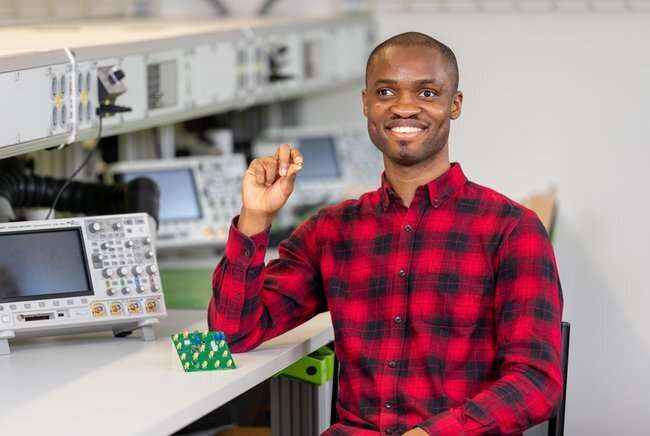
Being able to see without eyes sounds like a miracle, but in the not-too-distant future, a new brain chip could allow the blind and visually impaired to perceive images again. Ph.D. student Adedayo Omisakin worked on wireless communication from and to this innovative implant. He defended his research at the department of Electrical Engineering on Friday April 22nd.
Blind singer Stevie Wonder expressed his enthusiasm last week for the smart glasses developed by TU Delft startup Envision. These glasses are equipped with a built-in camera and offer users greater independence by reading texts or locating objects. But in order to allow the blind and visually impaired to actually see images again—admittedly made up of pixels—the camera in the glasses needs to be linked to an implant. That is the objective of Dutch research program NESTOR, a consortium consisting of scientists from various institutes, including the Netherlands Institute for Neuroscience, the University of Twente, Radboud University, Maastricht University, and TU/e.
Briefly explained: The camera images taken with the glasses that the blind person is wearing are processed in a mini computer, and subsequently transmitted wirelessly to a brain chip. The chip consists of multiple electrodes that stimulate cells in the visual cortex with electric currents, as Adedayo Omisakin explains. Within the NESTOR project, Ph.D. student Tom van Nunen, project leader Mark Bentum, and Omisakin work on the wireless communication part. Van Nunen, who will defend his thesis later this year, worked on the wireless power supply of the implant, whereas Omisakin focused on wireless communication from and to the implant.
Damaged nerves
“Many blind people have damaged nerves between the eyes and the brain, which is why our only option is to directly stimulate the visual cortex. For that, you need an external camera, image processing, and implanted electrodes, preferably without wires, because this not only prevents infections in the brain area from occurring, but also makes patients much more mobile.” Omisakin talked to several neurologists and neurosurgeons, and he was allowed to visit the American manufacturer of the electrodes. “The electrodes are grouped into 16 tiles, with 64 active electrodes each. That’s a staggeringly high total of 1,024 electrodes. We decided to place the central transceiver, which communicates with the tiles, just below the skin. This way, we won’t have any unnecessary signal loss induced by the skull.”
Over a period of four years, Omisakin turned into a super-engineer, he says with a smile. “I did everything from conceptualization to validation. First, I compared various potential communication techniques and delved into many details: data rates, power consumption, frequency bands. Next came the lab work. A lot of lab work. But we soon managed to achieve a promising data rate in our demonstration model. And we even got to a consumption of less than 1 mW in an integrated circuit with the use of special semiconductor technology.”
Epilepsy
That’s good news, because previous implants consumed a lot of power, which potentially leads to epileptic seizures in patients. Jens Naumann was one of those patients. The Canadian was one of the first blind people who was able to (briefly) see again thanks to a brain implant. However, the severe epileptic seizures and the many infections caused by the wires protruding from his head eventually forced the partial removal of the implant. Omisakin met with Naumann during one of the NESTOR meetings and was impressed by his enthusiasm for Omisakin’s research. This only inspired the Ph.D. student even more to develop wireless communication technology for brain chips. “Researchers from the Netherlands Institute for Neuroscience already tested the new brain chips with 1,024 electrodes in monkeys, and the monkeys were able to perceive characters, moving objects, and lines. Our system too is ready for testing, after a few adjustments. The number of electrodes eventually needs to be increased further if we want to have images of a usable quality. We are making serious progress, but we aren’t there yet. Still, I believe that we will be able to make a difference for the blind and visually impaired with this technology within the next five to ten years.”
Source: Read Full Article
